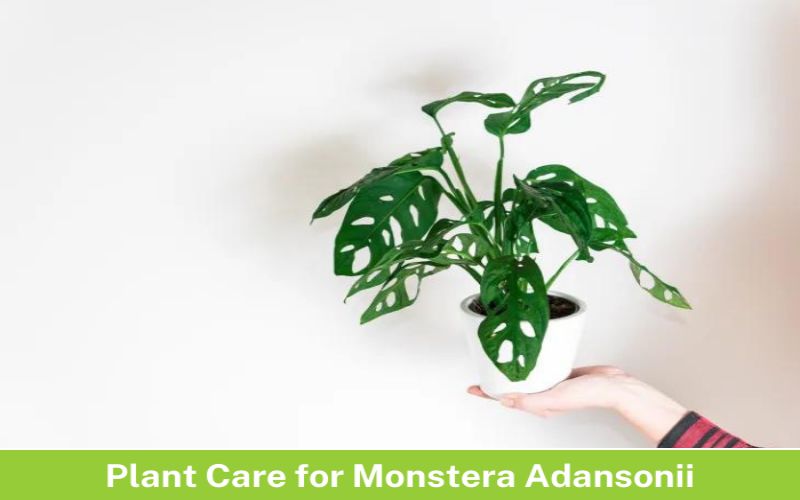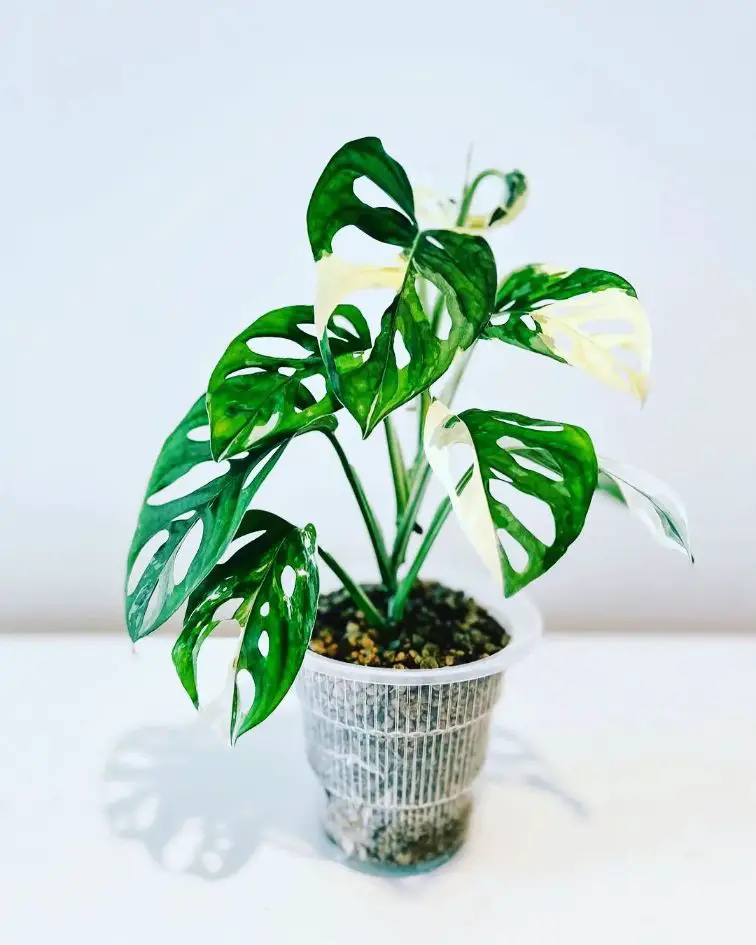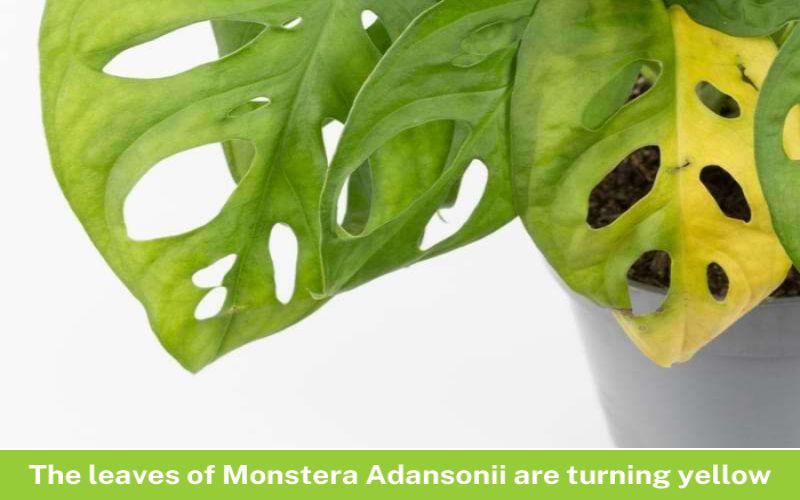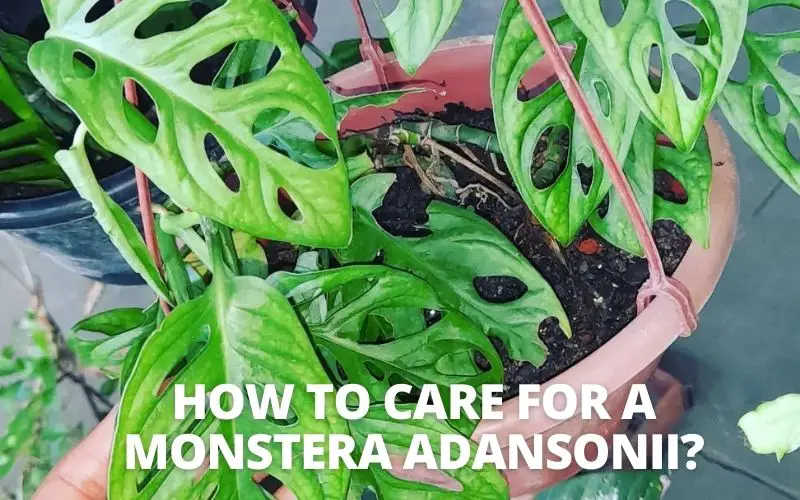Monstera adansonii, or Swiss cheese plant, is one of the most popular houseplants around. It frequently appears in Instagram posts and home décor magazines, and for good reason! But how to care for a Swiss cheese plant?
Before you run out and buy a Monstera adansonii, there are a few things you need to know to ensure plant growth. In this guide, I’ll go through every facet of caring for this plant, from the basics to fixing typical issues.
In This Article
What Is A Monstera Adansonii?
Why Is It A Popular Houseplant?
Monstera adansonii, or Swiss cheese plants, are popular indoor plants for a reason. Its beautiful, fenestrated leaves give it a unique appearance, and it can be trained to grow in various shapes and sizes as an ornamental.
The fenestrations, or holes in the leaves, are thought to help the plant reduce wind resistance and allow more light to reach the lower leaves. Thanks to this, it’s relatively easy to care for, even for beginners.
What Are The Benefits Of Growing A Monstera Adansonii?
The plant is a natural air purifier, especially beneficial for people who live in urban areas and small spaces. It is also a good choice for people who have allergies, as it is a low-pollen plant.Monstera adansonii’s lush foliage and calming presence can help create a relaxing and stress-free environment. Studies have shown that being around plants can help to reduce stress and improve overall well-being.
How To Take Care Of Swiss Cheese Plant

Light Conditions
Monstera adansonii needs bright, indirect light to thrive. It can tolerate some low light, but it will not grow as quickly or produce as many leaves. Avoid placing your plant in direct sunlight and drafts, as this can damage the leaves.
Place your plant near a south- or east-facing window. If your home is dimly lit, you can supplement it with grow lights. Grow lights should be placed 12-18 inches away from the plant and left on for 12-14 hours per day.
I’ve found one way to keep my Monstera adansonii healthy and happy: That is to wipe down the leaves regularly with a damp cloth or sponge. This helps to remove dust and dirt, helping the plant to absorb more light.
Be aware of the changing seasons and adjust the monstera adansonii light accordingly. Pale or yellow leaves are one of the first indicators that you need to change or closely monitor the lighting.
If you’re not sure how much light your Swiss cheese plant is getting, use a light meter app on your phone. This will help you to determine if your plant is getting enough light or too much light.
Watering
Monsteras like moist soil, but it’s important not to overwater them. Overwatering is one of the leading causes of root rot, which can wilt your plant.
Here are some signs that your plant is overwatered:
- The leaves are yellowing and falling off.
- The stems are brown and mushy.
- The roots are black and slimy.
Here’s my tip to avoid overwatering: I put a finger into the top inch of soil to check the moisture level. When the top inch of soil feels dry, I feed my plant a room-temperature drink.
Make sure the drainage holes are unclogged so any excess water can escape.
Note that watering frequency will vary depending on the climate. In dry seasons, you may need to water more often, while in humid ones, you may need to water less often. Reduce watering frequency during the winter months.
Monstera adansonii’s leaves are thinner and hold less moisture than those of Monstera deliciosa, so it requires more frequent watering.
Swiss Cheese Plant Soil
The best soil for Swiss cheese plant is a well-draining fresh soil mix that is also rich in nutrients. Organic matter can improve drainage and aeration while providing nutrients for the plant.
Avoid using soils that contain clay or peat moss, as these materials can retain too much water.
To improve the drainage and aeration of your potting mix, you can add a handful of compost or worm castings, or place a layer of pebbles or gravel at the bottom of the pot.
Temperature & Humidity
Do you know what Monstera adansonii loves? Warm, humid weather! They thrive in an ideal temperature range from 65 to 80 degrees Fahrenheit (18 to 27 degrees Celsius) and humidity levels between 50 and 60 percent.
I’ve been growing Swiss cheese plants for a few years now, and I’ve found that these are favorable conditions for my potted Monstera. If you live in a dry climate, prevent a lack of humidity for your plant by misting it regularly, placing it on a pebble tray, or using a humidifier.
Fertilizing
Monstera adansonii needs regular fertilization during the spring and summer months.
The most important thing I’ve learned is to use a balanced fertilizer diluted to half strength. You can mix a balanced amount of nitrogen, phosphorus, and potassium to make one.
Another option is to fertilize your house plants with organic matter, such as compost or worm castings. I like to add a handful of compost or worm castings to the top of the soil every few months.
Support For Climbing
In the wild, Monstera adansonii climbs trees and other plants using its aerial roots. If you are growing indoors, you will need to provide it with some support to climb.
I’m a huge fan of using moss poles to train Monstera to climb. They’re natural, look great, and provide the plant with something to grip onto with its aerial roots.
Choose a support that is the right size for your plant and place it in the center of the pot. Secure it firmly and gently tie the plant to the support using soft string or garden ties. Continue to tie the plant and mist the moss pole regularly as it grows.
Pruning
Prune your Swiss cheese vine during the growing season to encourage new growth, remove dead or dying leaves and stems, shape the plant, or control its size.
The best place to prune is just above a node. It will encourage your plant to grow back fuller and stronger. And be sure to leave at least two-thirds of the plant intact, so that it doesn’t get too stressed out.
After pruning, water the plant to flush out any bacteria or fungi that may have entered the wounds. I also often apply a fungicide to the wounds to help prevent infection.
Pests & Diseases
Some of the most common pests that can affect Monstera adansonii include spider mites, mealybugs, aphids, and thrips. These pests can feed on the sap of the plant, causing the leaves to turn yellow and drop off.
Use insecticidal soap or neem oil to get rid of any pests you see. Insecticidal soap works by coating the pests’ bodies and suffocating them. Neem oil works by disrupting the pests’ hormones and preventing them from reproducing.
Regarding diseases, root rot, leaf spot, and blight are 3 main culprits behind the Monstera’s stunted growth or even death. These diseases can stem from fungal infection, overwatering, or poor drainage.
Treating these diseases with a fungicide is the most effective way . You may need to reapply the fungicide every few days until the fungus is gone.
Monstera Adansonii Varieties
Adansonii: Medium-sized, heart-shaped leaves with deep holes.
Laniata: Large, deeply lobed leaves with a glossy, metallic sheen.
Variegata: Leaves variegated with white and cream.
Archipelago: Heavily variegated leaves that appear more white than green.
Aurea: Leaves variegated with yellow and cream.
Read more: Monstera Varieties: 15 Amazing Types of Monstera Plant
How To Grow From Seed
Steps to Follow
Step 1. Gather your supplies: seeds, seed starting mix, seed starting tray or pots with drainage holes, plastic wrap or a humidity dome, water, grow light (optional)
Step 2. Before planting, soak the Monster seeds in lukewarm water for about 24 hours. Doing this can soften the seed coat and facilitate germination.
Step 3. Fill your tray or pot with the starting mix. Plant your seeds 1/4 inch deep and water well. Cover the tray or pot with plastic wrap or a humidity dome.
Step 4. Monitor and water your seeds. Place your seeds in a warm, well-lit location. Germination should occur between 2-4 weeks.
Step 5. Once your seeds have germinated, remove the plastic wrap or humidity dome.
Step 6. Water your seedlings regularly and fertilize them once a month.
Step 7. Once your seedlings have outgrown their seed starting tray or pots, transplant them into the prepared pots.
Step 8. Continue to water and fertilize your plant regularly.
Potting & Repot

What pot to choose: Choosing a larger container with drainage holes. This will help to prevent the plant from becoming rootbound too quickly.
What potting mix to use: Monstera adansonii plants prefer a well-drained potting soil. You can purchase the specifically designed for aroid plants, or you can make your own by mixing pertile, orchid bark, and peat moss, each with an equal part.
How to pot and repot: Gently remove the plant from its current pot and loosen the roots. Place the plant in the new pot and backfill with potting mix, tamping down gently to remove any air pockets.
How To Propagate Swiss Cheese Plant
Propagating is an easy way to get plant babies for your home or to share with friends.
To propagate in water, cut a healthy stem below a node, remove the bottom leaves, and place the stems in a glass of water with the node covered. Take the glass in bright, indirect light exposure and change the water every few days.
When the roots are at least 2 inches long, transplant the plant into a pot with a well-draining soil mix.
How Do I Know If My Monstera Adansonii Is Healthy?
In the whispers of Monstera, I’ve learned to understand its language to assess its health.
Leaves: The leaves should be deep green and glossy, free of pests and diseases.
Stems: If the stems are free of pests and diseases, strong and sturdy, it’s a good sign
Roots: A healthy Monstera adansonii likely has firm and white roots.
Growth: Your plant is thriving if you notice it actively grows new leaves and stems.
FAQ
Why are my Monstera Adansonii’s leaves turning yellow?
First and foremost, don’t be concerned if you see an occasional yellow leaf. That is a plant’s natural growth pattern.

It’s difficult to pinpoint the exact cause without additional information such as pot size, soil type, watering schedule, and the environment of your home. Yellowing leaves can be caused by a variety of factors, including inconsistent watering (either too much or too little), excessive fertilization, excessive light exposure (either too much or too little), a heavy soil mix, or a lack of drainage.
How do I fill out a Monstera Adansonii?
This is useful information for Monstera Adansonii care. These plants grow so quickly that they can become leggy. To avoid this, tip prunes the stems (anywhere from 1 to 4 leaf nodes down) on a regular basis.
Alternatively, you can prune more aggressively as needed.
Is it necessary to stake my Monstera Adansonii?
If you want, you can. Although this plant is commonly sold as a trailing plant, many people (including myself!) train it to grow upwards.
Why are the tips of my Monstera Adansonii leaves brown?
If yours has small brown tips, it is due to dry air. If the tips are larger, it is usually due to overwatering.
Does Monstera Adansonii enjoy being root-bound?
They don’t mind being slightly root-bound, as you previously stated. The roots of this plant grow quickly. When the roots become too tight and wrap around each other, it’s time to repot.
Monstera Adansonii maintenance is simple. This plant will be a fun addition to your houseplant collection regardless of how you train it.
Conclusion
Although Monstera Adansonii is a simple plant to care for, it is essential to research and comprehend the fundamentals of its upkeep. By following these caring tips, your plant will thrive and bring you joy for many years.


